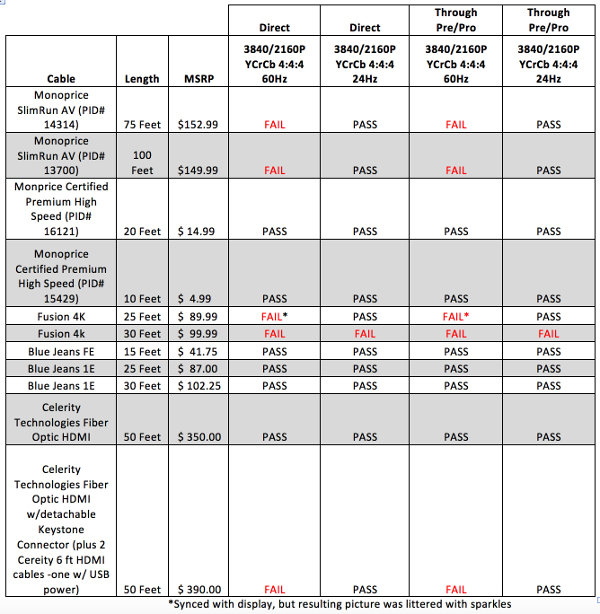UHD Blu-ray vs. HDMI – Pt. 2: Which Cables Can Actually Pass HDMI 2.0? Page 2
Let The Games Begin
My findings are summarized in the table below. As with my earlier testing, there were some issues with active cables. While the Monoprice Slimrun AV HDMI cables were by far the longest in the test, neither could lock onto the 17.82Gbps signal coming out of the Samsung—either hooked up directly or through the Marantz pre/pro. Each Slimrun cable was able to pass the 4K/24Hz signal though. Furthermore, each of the HDMI Premium Certified cables from Monoprice passed with flying colors. At $14.99 for the 20 foot run, it’s one hell of a bargain.

The Fusion 4K cables were a mixed bag. While they both worked for 1080p, the 30-foot cable was a complete loss for 4K—both at 60 and 24Hz. The 25-foot cable passed at 24Hz but not at 60Hz.
Blue Jeans Cables deserves high praise. Its Series-FE HDMI Premium Certified Cable passed with ease, as did both its 25- and 30-foot non-certified cables. The only downside to the non-certified cables is they are stiff and heavy, so they won’t bend easily around corners if you’re doing an in-wall installation. From a value perspective, though, they are relatively inexpensive compared with the 10-meter (33 foot) Audioquest Carbon cables from my earlier test, which sells for $889—more than 8 times the cost. Granted, buying direct over the Internet cuts out the middleman, so some savings are certainly passed on to the customer from Blue Jeans Cables.
Finally there’s the Celerity fiber optic cable, which did well when using the detachable fiber optic (DFO) HDMI leads coupled with a USB power source on the receiving side. However, I couldn’t get the keystone ends to pass the highest bandwidth signals properly on both ends. The DFO heads and keystone connectors are interchangeable, so I was able to determine that using a DFO on the source side and a keystone plate on the receiving side worked like a charm. But as soon as a keystone connector was used at the source, it would no longer pass the 4K/60Hz signal. I really liked how Celerity’s keystone solution presented an opportunity for a very clean install, but in the end it didn’t pan out.
HDMI Still, Well...
In Round 1 of my testing I determined that HDMI sucks, and I don’t think my opinion will change anytime soon. Sure, it makes hooking up sources much simpler versus the gaggle of analog cables we lived with, but at longer cable lengths, HDMI signals just degrade too quickly.Fortunately, though, these latest results suggest a future that looks to be a bit brighter than it did earlier this year. For lengths up to 30 feet or so, passive cables can work well as long as the cable is of sufficiently high quality, as evidenced by the Blue Jeans Cable offerings. At 20 feet or less, HRMI Premium Certified cables appear to be rock solid, and with a 28 AWG diameter, they are not as stiff and inflexible as the 24 AWG cable used for longer runs. If you're going more than 30 feet or so, fiber looks to be your only real option if you want a cable that delivers the whole enchilada. While pricey, the Celerity is a great option when mated with its DFO solution and it's said to support cable runs up to 1,000 feet long.
In closing, I’d like to point out that this testing is a worst cast/most-demanding scenario for HDMI bandwidth: Signals of 3840 x 2160p, 60Hz, with YCrCr 4:4:4 encoding, are really only seen now with the Samsung player's menus and how it handles YouTube videos with its “Auto” or “2160P” output setting. UHD discs, currently our best-quality real content, are less bandwidth intensive at 3840 x 2160p, 24Hz. That being said, who knows what the future holds? If you're installing a long signal cable today, getting one that’s able to fully utilize the current HDMI 2.0a/b specification tomorrow may save you some serious heartache in the future.
























































